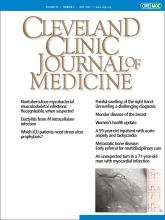
In this issue of the Journal, we have 2 Clinical Picture articles1,2 portray and emphasize a shared clinical theme. Both depict patients with peripheral musculoskeletal infections with nontuberculous mycobacteria. One was an infection with Mycobacterium intracellulare and the other with Mycobacterium marinum. These papers were independently submitted in the same time frame from medical centers half a world apart. Serendipitously, the second crossed my desk while I was coordinating a repeat surgical intervention on a patient of mine with recurrent M intracellulare infection of a finger proximal interphalangeal joint and flexor tendon. I’ll say a bit more about that patient below.
These stories of patients with nontuberculous mycobacterial (NTM) infections share distinctive historical and physical examination components. The stories and pictures offer important diagnostic caveats, especially for those who don’t frequently consider such infections in the diagnosis of patients with swollen, indurated peripheral soft-tissue structures. (And that would be most of us.)
NTM musculoskeletal infections are not common and tend to be indolent. As a result, the diagnosis is often delayed3 for many months, as in the patients pictured in this issue. Multiple species of these bacteria are ubiquitous in the environment, and the source of infection often cannot be identified. Many species exist in soil. M marinum is considered to be a waterborne infection (in the wild as well as in home aquariums). It is important to recognize when M marinum may be the infectious agent so as to notify the microbiology laboratory not only to set up protracted routine mycobacterial cultures at 37°C but also to incubate parallel cultures at cooler temperatures to facilitate M marinum growth.
Cost-conscious care dictates that it is not necessary or reasonable to send fluid from all potential musculoskeletal infections for mycobacterial or fungal cultures at initial evaluation. NTM joint infections tend to have an insidious onset and can be confused with more typical bacterial infections, which should be excluded. No growth on routine cultures and the lack of a clinical response to empiric antibiotics should raise a red flag when there is concern for a possible infected joint.
The diagnosis of NTM infection is reasonable to consider in patients who present with chronic, unexplained, indurated peripheral tendon sheaths. Particularly challenging can be the management of patients described in this issue,1,2 who have an underlying rheumatic condition or are receiving immunosuppressive therapy. Suspicion of NTM infection should increase if a patient being treated for a systemic inflammatory arthritis responds in most involved areas but is not responding as expected in adjacent anatomic areas, or if there are anatomic quirks on examination. In the patient pictured by Shimizu et al,1 a clinical clue to NTM infection was dactylitis of a single finger in a patient with rheumatoid arthritis. Rheumatoid arthritis is not expected to elicit dactylitis! Also, the presence of chronic distended hand or foot tenosynovitis resistant to anti-inflammatory therapy should raise concern for NTM infection, even in the absence of any known immunodeficiency. These infections tend to not be dramatically painful but can cause significant functional limitations or even nerve compression (eg, carpal tunnel syndrome). The markedly chronic nature of these infections is highlighted by the frequent presence of chunks of infarcted synovium and cellular debris, so-called “rice bodies,” which used to be characteristic of chronic severe undertreated rheumatoid arthritis but now are found more frequently in the setting of chronic infection.3
While NTM infections may also be limited to the lungs, they can be systemic, particularly in markedly immunodeficient patients such as those with undertreated HIV/AIDS. Musculoskeletal infections often remain limited to local areas of bone (vertebral osteomyelitis) or joint (usually monoarticular or oligoarticular), and especially tendon sheaths and surrounding tissue. Patients with musculoskeletal infections may not have a fever and may have normal acute-phase reactants.3,4 Often, the patient provides a history of injury, surgical intervention, or prior inflammation of an affected joint. I have cared for a patient with rheumatoid arthritis and isolated M intracellulare infection in a prosthetic hip joint.
My recent patient with palmar flexor tendon sheath infection with M intracellulare manifested many of the above demographic characteristics. He is a renal transplant recipient, who had been doing well on mycophenolate and cyclosporin immunosuppression. He developed crystal-proven gout in multiple areas including metacarpal phalangeal (MCP) joints, with uric acid deposits documented by ultrasonography. He was treated with a several-month course of pegloticase to dissolve the deposits, and his hand function improved. But after switching back to traditional oral urate-lowering therapy, the third MCP and flexor tendons started to enlarge, despite maintaining a serum urate level below saturation (6.8 mg/dL). It was felt to be unlikely for gout inflammatory symptoms to return after the (presumed) dissolution of the uric acid deposits with persistent low serum urate. A biopsy was done and the infection was documented. He was treated successfully, or so it seemed, with “radical tenosynovectomy” and sensitivity-directed multidrug therapy for more than 6 months. More than a year after the antibiotics were stopped, doughy swelling of the palmar tendons and MCP joint returned, with mild flexion contractures. He was taken again to the operating room, and granulomatous tenosynovitis was identified and resected. Additionally, innumerable rice bodies were washed out. No crystals were reported by the laboratory. We are currently awaiting the antibiotic sensitivities.
Although still uncommon, with the widening use of potent immunosuppressive therapies, NTM musculoskeletal infections are increasingly recognized, but there is still a protracted delay in diagnosis. Hopefully, the images presented here will heighten awareness of these infections and prompt appropriate diagnostic evaluation, which often requires tissue-sampling.
- Copyright © 2022 The Cleveland Clinic Foundation. All Rights Reserved.






